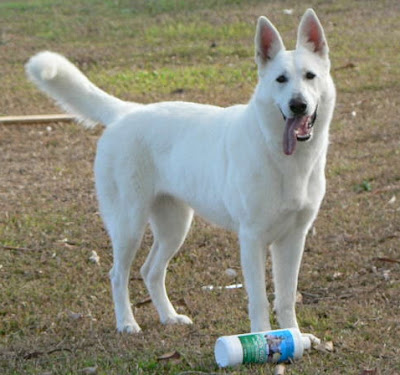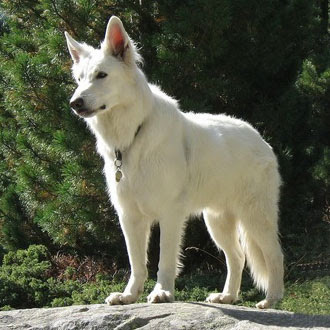 |
| Berger Blanc Suisse |
The Weisser Schweiser Schaferhund or Berger Blanc Suisse (White Swiss Shepherd), was often considered a mutation of the German Shepherd, until recently when it was finally considered a separate breed after years of campaigning from White Shepherd enthusiasts. Currently, this breed is only recognised by the FCI and the UKC, but more efforts are being made to give the breed worldwide recognition as a separate and distinct breed from the German Shepherd.
The Berger Blanc Suisse or White Shepherd as the name implies should be white with a medium length coat though a light cream color is also acceptable. The dog should be medium sized 24"-26" and 75-85 lbs for Dogs and 22"-24" and 60-70 lbs for Bitches. They should also be muscular with smooth curves. Many people believe their temperament is the same as the German Shepherd. However, many also feel the white shepherds have a less aggressive temperament compared to the traditional German Shepherd.
History Berger Blanc Suisse or White Shepherd
The History of the Berger Blanc Suisse or White Shepherd is the generally the same as that of the German Shepherd. The White Shepherd is the result of some breeders not wanting the white color so over time the white dogs became their own breed. White coated herding dogs of rural Germany were an essential part of the late 19th century breeding program that founded the German Shepherd breed. It is a historical fact that a white herding dog named Greif was the Grandfather of Horand von Grafrath, the dog acknowledged as the foundation of all contemporary German Shepherd Dog bloodlines. “Der Deutsche Schaferhund In Wort Und Bild’ written by the recognized father of the breed, Rittmeister (Cavalry Captain) Max von Stephanitz, in 1921 included a photo of a White German Shepherd directly descended from Horand.
Information provided in early books on the German Shepherd Dog , such as "The Alsatian WoIf Dog" written by George Horowitz in 1923, as well as "The German Shepherd, Its History, Development and Genetics" written by M. B. Willis in 1977, make mention of white German Shepherds shown in Europe as early as 1882. From the very first German Shepherd Dog forward to the German Shepherds of today, the recessive gene for white colored coats has been carried in the DNA of the breed.
 |
| White swiss Shepherd |
Shepherding was a common way of life for thousands of years all across Europe, including the countryside that is today called Germany. Over countless centuries shepherds used dogs to herd their sheep throughout the day, and guard them against wolf and bear predators at night. The Roman writer Columella in the 1st century A.D. published a 35-volume essay on agriculture entitled, “The Agricultural Arts” that stated, unequivocally, the dogs that guard the sheep are white in color. Earlier in history, the Roman historian and writer, Marcus Terrentius Varro (116-27 B.C.), described the guardians of the flocks as being invariably white in color. He also writes that, in his opinion, the shepherds preferred white dogs in order to be able to distinguish them from the wolves that usually attacked in the half-light of dawn or dusk.
 |
| Berger Blanc Suisse |
Many descendants of the ancient shepherd's white dogs were present on 19th century German farms. In addition to the somewhat larger white guard and herding dog varieties, several varieties of medium sized shepherding dogs were also in use on German farms. These medium-sized shepherd dogs were especially fast and agile dogs that were particular well suited to moving and guiding sheep herds across the country side. These medium-sized dogs had coat colors of brown, grey, grizzled and white. For example, the medium-sized Puli, was known to have white coats and the Sharfpudel of Germany was always white. It is, therefore, a fact, that the modern German Shepherd Dog bread presents all of the coat colors, including white, of the breeds founding ancestors.
Across the regional landscape of 19th century German farms, Shepherds bred a wide variety of dogs to herd their sheep with no uniformity of size, color, or shape, except for what was common for their particular region. The only real interest was that herding dogs be physically and mentally sound so they could work tirelessly, competently and faithfully along side the shepherd. This was the landscape seen by Max Von Stephanitz in the 1880s. As a young cavalry officer, Stephanitz’s military duties often required him to travel across the German countryside. It was common for travelers like Stephanitz to board with rural families along the way. At that time most rural German farms had at least a few head of sheep and a herding dog or two to tend them. Stephanitz became fascinated with the German herding dogs and their working capabilities. He admired all the hard working dogs, but observed some dogs had a special look and bearing about them that he especially admired.
Eventually Stephanitz became inspired with the idea that Germany should have a national herding dog that combined the work ethic of the most accomplished herding dogs with that special look and bearing he so admired. Stephanitz envisioned a German shepherding dog who was extremely intelligent, could reason and be a working companion to man. Further, the dog must be quick on his feet and well coordinated, protective, noble in appearance and bearing, trustworthy in character, physically sound in joint and muscle, and be born with an innate desire to please and obey the shepherd master. This is the German Shepherd dog that we know and love today. By 1891 Stephanitz started selecting the best herding dogs from across the German countryside for his breeding program, but Stephanitz was not alone in his passion to develop a national German Shepherding Dog.












0 comments:
Post a Comment